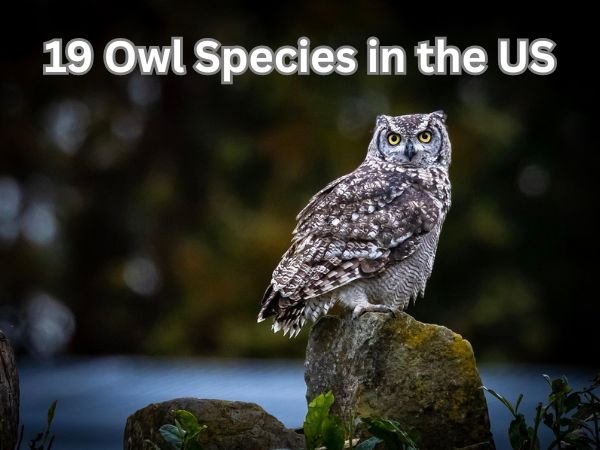
When people hear about the “19 Owl Species in the US,” two things usually come to mind: First, the thrill of spotting a mysterious owl in the wild, with its silent wings and piercing eyes. Second, the challenge of actually identifying which owl you’ve seen—since these fascinating birds come in a surprising variety of shapes, sizes, and colors. From the tiny Elf Owl to the majestic Great Horned Owl, the United States is home to an incredible diversity of owl species, each playing a unique role in our ecosystems.
In this easy-to-follow owl identification guide, we’ll introduce you to all 19 owl species in the US, share expert tips for recognizing them in the wild, and answer your most common questions about their habits and habitats. Whether you’re a curious pet owner, a backyard birder, or just someone who loves wildlife, this guide will give you the actionable advice and insights you need to spot, appreciate, and help protect these remarkable birds. Let’s dive in and discover the hidden world of America’s owls together!
Owl Identification Basics
Learning owl identification can be fun and rewarding. With a few key tips, you can start to tell different owl species apart, whether you’re a beginner or an experienced birdwatcher. Using an owl field guide and practicing in the field will help you improve your skills.
Key Features for Owl Identification
- Size:
Owls come in many sizes, from the tiny Elf Owl to the large Great Horned Owl. Compare the owl to birds you know, like robins or ducks, to estimate its size. - Ear Tufts:
Some owls have feather tufts that look like ears on top of their heads (like the Great Horned Owl), while others have round, smooth heads (like the Barn Owl). Ear tufts can be long, short, or missing altogether. - Eye Color:
Owl eyes can be yellow, orange, or dark brown. Eye color is often a helpful clue for identification. - Plumage (Feather Color and Markings):
Look at the color and patterns on the owl’s feathers. Some have spots, streaks, or bars. Many owls have colors that help them blend into trees or grass. - Vocalizations:
Each owl species has its own call. Some hoot, others screech, bark, or whistle. Learning a few common calls can help you find and identify owls, even if you can’t see them. - Habitat:
Notice where you see the owl. Some owls live in forests, others in grasslands, deserts, or even city parks. The habitat can give you clues about which species you are seeing. - Activity Patterns:
Most owls are nocturnal (active at night), but some, like the Short-eared Owl and Snowy Owl, are often seen during the day. Dusk and dawn are good times to look for many species.
Tips for Beginners and Birdwatchers
- Use an Owl Field Guide:
Bring a field guide with photos or drawings of local owls. This will help you compare features and narrow down your choices. - Listen and Watch:
Sometimes it’s easier to hear an owl than to see one. Listen for calls, and watch for movement at dusk or dawn. - Look for Signs:
Check for owl pellets (regurgitated fur and bones), white droppings under trees, or alarm calls from other birds. These can all mean an owl is nearby. - Be Patient and Quiet:
Owls are shy and well-camouflaged. Move slowly, stay quiet, and give yourself time to spot them. - Check the Habitat:
Know which owls live in your area and what habitats they prefer. This will help you focus your search. - Respect Wildlife:
Don’t get too close or disturb owls, especially near nests. Use binoculars or a camera with a zoom lens to observe from a distance.
With these basics and a good owl field guide, you’ll be ready to enjoy owl identification and learn more about these amazing birds. Happy owling!
Detailed Profiles: The 19 Owl Species in the US
Below are short, consistent profiles for each of the 19 owl species found in the United States. Each profile covers their common and scientific names, description, range and habitat, behavior, vocalizations, conservation status, and a fun fact.
Barn Owl (Tyto alba)
- Description: Medium-sized, with a white, heart-shaped face, golden-brown back, and white underparts. Wings are long and rounded.
- Range and Habitat: Found across the US in open areas, farmland, grasslands, and cities. Roosts in barns, tree cavities, and cliffs.
- Behavior: Nocturnal hunter; flies silently to catch rodents and small birds.
- Vocalizations: Raspy hiss or screech, not a hoot.
- Conservation Status: Stable in many areas, but habitat loss is a threat.
- Fun Fact: Sometimes called the “monkey-faced owl” for its unique face shape.
Barred Owl (Strix varia)
- Description: Large, stocky, with a round head and no ear tufts. Brown eyes and horizontal bars on the chest.
- Range and Habitat: Forests and swamps in eastern and northwestern US.
- Behavior: Nocturnal; hunts small animals using keen vision and hearing.
- Vocalizations: Famous for its “Who cooks for you, who cooks for you all?” hoot.
- Conservation Status: Stable, but expanding range can threaten other species.
- Fun Fact: Has asymmetrical ears for pinpointing prey in darkness.
Boreal Owl (Aegolius funereus)
- Description: Small, with a large head and yellow eyes. Brown above with white spots, pale below with brown streaks.
- Range and Habitat: Dense boreal forests in Alaska and northern Rockies.
- Behavior: Nocturnal; flies quietly and hunts small mammals.
- Vocalizations: Soft, whistling “po-po-po-po.”
- Conservation Status: Stable but sensitive to habitat changes.
- Fun Fact: Its “eyebrows” give it a surprised look.
Burrowing Owl (Athene cunicularia)
- Description: Small, long-legged, brown with white spots, yellow eyes, and no ear tufts.
- Range and Habitat: Open grasslands and deserts in the West and Florida; lives in burrows.
- Behavior: Active during day and night; hunts insects and small animals.
- Vocalizations: Soft coos and rattling sounds.
- Conservation Status: Declining due to habitat loss.
- Fun Fact: Often seen standing at burrow entrances, bobbing their heads.
Eastern Screech-Owl (Megascops asio)
- Description: Small, with ear tufts, yellow eyes, and comes in gray or reddish color phases.
- Range and Habitat: Forests, parks, and suburbs east of the Rockies.
- Behavior: Nocturnal; swoops from perches to catch varied prey.
- Vocalizations: Descending trill or whinny.
- Conservation Status: Stable.
- Fun Fact: Can make itself look like a tree branch to avoid predators.
Elf Owl (Micrathene whitneyi)
- Description: Tiny (about 6 inches long), brownish with a short tail and no ear tufts.
- Range and Habitat: Deserts and canyons of the Southwest, especially Texas and Arizona.
- Behavior: Nocturnal; hunts insects and small lizards.
- Vocalizations: High-pitched chuckles.
- Conservation Status: Vulnerable due to habitat loss.
- Fun Fact: Smallest owl in North America.
Ferruginous Pygmy-Owl (Glaucidium brasilianum)
- Description: Very small, brownish or rufous, with streaked chest and “false eyes” on the back of the head.
- Range and Habitat: South Texas and southern Arizona, in woodlands and brush.
- Behavior: Active at dawn, dusk, and sometimes day; hunts insects, birds, and small mammals.
- Vocalizations: Repeated “hoo-hoo-hoo.”
- Conservation Status: Rare in the US.
- Fun Fact: Attracts mobs of small birds that try to chase it away.
Flammulated Owl (Psiloscops flammeolus)
- Description: Small, gray-brown with flame-like markings and dark eyes.
- Range and Habitat: Mountain pine forests in the West.
- Behavior: Nocturnal and migratory; hunts insects.
- Vocalizations: Deep, soft hoots.
- Conservation Status: Stable but depends on healthy forests.
- Fun Fact: Migrates to Central America for winter.
Great Gray Owl (Strix nebulosa)
- Description: Very large, gray with a big round face and yellow eyes. Has a white “bow tie” under the beak.
- Range and Habitat: Boreal forests and mountain meadows in the northern US and Alaska.
- Behavior: Mostly nocturnal; hunts from perches, plunges into snow for prey.
- Vocalizations: Deep, rhythmic hoots.
- Conservation Status: Not threatened, but needs large forest areas.
- Fun Fact: Largest owl by length in the world.
Great Horned Owl (Bubo virginianus)
- Description: Large, with long ear tufts, yellow eyes, and mottled brown plumage.
- Range and Habitat: Widespread across North America in many habitats.
- Behavior: Nocturnal; powerful hunter, can take large prey.
- Vocalizations: Classic deep “hoo-hoo-hoo.”
- Conservation Status: Stable.
- Fun Fact: Has a grip strong enough to sever the spine of large prey.
Long-eared Owl (Asio otus)
- Description: Medium-sized, with long ear tufts and orange eyes. Brown with streaks.
- Range and Habitat: Dense forests and open country across the northern US.
- Behavior: Nocturnal; hunts small mammals.
- Vocalizations: Soft, repeated “hoo.”
- Conservation Status: Stable but hard to spot.
- Fun Fact: Roosts in groups during winter.
Northern Hawk Owl (Surnia ulula)
- Description: Medium-sized, with a long tail and yellow eyes. Brown above, white with bars below.
- Range and Habitat: Alaska and northern Canada; sometimes northern US. Prefers open forests and tundra.
- Behavior: Hunts by day and night; perches high and swoops down on prey.
- Vocalizations: Fast, burbling trills.
- Conservation Status: Not threatened, but numbers change with prey.
- Fun Fact: Looks and acts a bit like a hawk.
Northern Pygmy-Owl (Glaucidium gnoma)
- Description: Tiny, brown with white spots and “false eyes” on the back of the head.
- Range and Habitat: Forest edges in the West.
- Behavior: Hunts mostly during the day; perches and pounces on small birds and mammals.
- Vocalizations: High-pitched “toots.”
- Conservation Status: Not threatened, but declining in some areas.
- Fun Fact: Fierce hunter for its size.
Northern Saw-whet Owl (Aegolius acadicus)
- Description: Small, reddish-brown with a big round head and yellow eyes.
- Range and Habitat: Coniferous forests across much of North America.
- Behavior: Nocturnal; hunts mice and small birds.
- Vocalizations: Repeated, high-pitched whistles.
- Conservation Status: Not threatened.
- Fun Fact: Named for its call, which sounds like a saw being sharpened.
Short-eared Owl (Asio flammeus)
- Description: Medium-sized, mottled brown with short ear tufts and yellow-orange eyes.
- Range and Habitat: Grasslands, marshes, and prairies across the US.
- Behavior: Active at dusk and dawn; flies low over fields to hunt.
- Vocalizations: Scratchy barks and hoots.
- Conservation Status: Declining due to habitat loss.
- Fun Fact: Often seen flying during the day.
Snowy Owl (Bubo scandiacus)
- Description: Large, white with some dark spots. Males are whiter; females have more markings.
- Range and Habitat: Arctic tundra; winters in northern US, open fields, and coasts.
- Behavior: Active day and night; hunts lemmings and other small animals.
- Vocalizations: Deep hoots, but mostly quiet.
- Conservation Status: Vulnerable due to climate change.
- Fun Fact: Only mostly white owls in the world.
Spotted Owl (Strix occidentalis)
- Description: Medium-sized, brown with white spots and dark eyes.
- Range and Habitat: Old-growth forests in the West.
- Behavior: Nocturnal; hunts flying squirrels and small mammals.
- Vocalizations: Four-note hoot.
- Conservation Status: Threatened by habitat loss and competition with Barred Owls.
- Fun Fact: Needs large, old forests to survive.
Western Screech-Owl (Megascops kennicottii)
- Description: Small, gray or brown with ear tufts and streaked body.
- Range and Habitat: Woodlands, deserts, and suburbs in the West.
- Behavior: Nocturnal; hunts insects and small animals.
- Vocalizations: Series of trills and whistles.
- Conservation Status: Stable.
- Fun Fact: Excellent at blending in with tree bark.
Whiskered Screech-Owl (Megascops trichopsis)
- Description: Small, gray or rufous, with whisker-like feathers around eyes and a pale yellow bill.
- Range and Habitat: Mountain forests in southern Arizona and New Mexico.
- Behavior: Nocturnal; hunts insects, reptiles, and small mammals.
- Vocalizations: Rapid, Morse code-like toots.
- Conservation Status: Rare in the US.
- Fun Fact: Best identified by its unique call.
These 19 owl species show the amazing diversity of owls in the United States, each with its own special features and adaptations.
Owl Habitats and Distribution in the US
Owls are found almost everywhere in the United States. Their homes, called habitats, are as diverse as the owls themselves. Understanding “owl habitats US” and “where do owls live” helps us see why different species choose certain places.
Main Types of Owl Habitats
- Forests:
Many owls, like the Barred Owl and Great Horned Owl, live in forests. These can be thick woodlands, old-growth forests, or even wooded parks. Forests give owls places to hide, hunt, and nest in tree cavities or on branches. - Grasslands and Prairies:
Some owls, such as the Short-eared Owl and Burrowing Owl, prefer open spaces like grasslands, prairies, and fields. Here, they can easily spot small animals to hunt. Burrowing Owls even nest underground in old animal burrows. - Deserts:
In the Southwest, owls like the Elf Owl and Western Screech-Owl live in dry deserts and scrublands. They nest in holes in cacti or trees and hunt insects and small animals at night. - Tundra:
The Snowy Owl is famous for living in the cold, open tundra of Alaska and northern states. These owls nest on the ground and hunt during the day, especially in winter. - Urban Areas:
Some owls have learned to live near people. Barn Owls and Barred Owls can be found in cities, suburbs, barns, and parks. They use buildings, tree cavities, and even nest boxes for homes.
How Habitats Influence Owl Distribution and Behavior
- Food and Shelter:
Owls pick habitats where they can find enough food and safe places to nest. For example, Barn Owls need open fields to hunt mice, while Barred Owls need large trees for nesting. - Adaptation:
Some owls can live in many kinds of places. The Great Horned Owl is found in forests, deserts, cities, and even wetlands. Others, like the Burrowing Owl, have very specific needs and are only found in certain areas. - Behavior:
Where an owl lives affects how it hunts and nests. Forest owls often hunt from perches, while grassland owls fly low over fields. Desert owls may nest in cacti, and tundra owls build nests on the ground. - Sharing Space:
In some places, several owl species can live close together if they use different parts of the habitat or hunt at different times.
Summary
Owls in the US live in forests, grasslands, deserts, tundra, and even cities. Their choice of home depends on where they can find food and safety. Each species has special ways of living that help it survive in its favorite place. So, wherever you are in the US, you might not be far from an owl’s hidden home.
FAQ
Can you keep an owl as a pet?
No, you can’t keep owls as pets in the U.S. without special permits. Owls need expert care, large spaces, and a special diet. They are wild birds, not good for home life. “Owl care” is best left to licensed rehabbers or zoos.
Are owls dangerous to people or other pets?
Owls are not usually dangerous to people, but they may attack if they feel threatened. Small pets can be at risk. For “owl safety,” keep pets indoors at night in areas where owls live.
What do owls eat?
The owl diet includes small animals like mice, rats, insects, frogs, and sometimes birds. Some big owls may eat rabbits or squirrels. Owls are meat-eaters and hunt live prey.
How do owls hunt?
Owls hunt mostly at night. They use sharp eyesight, silent flight, and strong claws. They sit quietly, watch for movement, and swoop down fast to catch their prey.
How do you attract owls to your yard?
To attract owls, put up a nest box, leave dead trees standing if safe, and avoid using chemicals. A quiet yard with trees and no bright lights helps. Also, don’t remove mice—they’re part of the owl diet.



